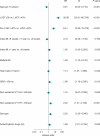Clinical practice of defibrillator implantation after myocardial infarction: impact of implant time: results from the PreSCD II registry
- PMID: 21123220
- PMCID: PMC3065916
- DOI: 10.1093/europace/euq426
Clinical practice of defibrillator implantation after myocardial infarction: impact of implant time: results from the PreSCD II registry
Abstract
Aims: Current guidelines recommend implantable cardioverter-defibrillator (ICD) therapy for primary prevention of sudden cardiac death in patients with the reduced left ventricular function (LVEF ≤30%) not earlier than 40 days after myocardial infarction (MI). The aim of the prospective Prevention of Sudden Cardiac Death II (PreSCD II) registry was to investigate the clinical practice of ICD therapy in post-MI patients and to assess the impact on survival.
Methods and results: 10,612 consecutive patients (61 ± 12 years, 76% male) were enrolled 4 weeks or later after MI in 19 cardiac rehabilitation centres in Germany from December 2002 to May 2005. All patients with left ventricular ejection fraction (LVEF) ≤40% (n = 952) together with a randomly selected group of patients with preserved left ventricular function (n = 1106) were followed for 36 months. Cox proportional hazard models were used to correlate ICD implantation and survival with baseline characteristics. Of all patients studied, 75.9% were enrolled within 4-8 weeks, 10.7% more than 1 year after MI. Pre-specified Group 1 with an LVEF ≤30% consisted of 269 patients (2.5%), Group 2 with LVEF 31-40% of 727 patients (6.9%), and Group 3 with LVEF >40% of 1148 randomly selected patients from the cohort of 9616 patients with preserved LV function. After 36 months, only 142 patients (6.9%) had received an ICD; 82 (31.7%) of Group 1, 49 (7%) of Group 2, and 11 (1%) in Group 3. The ICD was implanted in 47% of all patients within 1 year after their index MI. Implantable cardioverter-defibrillator patients were predominantly characterized by low ejection fraction, but also by several other independent risk factors. Patients who received an ICD had an adjusted 44% lower mortality (hazard ratio 0.56, 95% confidence intervals 0.32-1.01; P = 0.053) than comparable patients without ICD therapy. All cause mortality of ICD recipients was significantly lower if the ICD was implanted later than 11 months after acute MI (P < 0.001).
Conclusions: The PreSCD II registry demonstrated that the number of patients who develop a low LVEF (≤30%) after acute MI is small. However, only few patients with guideline-based ICD indication received ICD therapy. All cause mortality was significantly reduced only if the ICD was implanted late (>11 months) after MI.
Figures




Comment in
-
Timing of defibrillator implant after acute myocardial infarction: what's new?Europace. 2011 Apr;13(4):455-7. doi: 10.1093/europace/euq457. Epub 2010 Dec 24. Europace. 2011. PMID: 21186232 No abstract available.
References
-
- Huikuri HV, Tapanainen JM, Lindgren K, Raatikainen P, Mäkikallio TH, Juhani Airaksinen KE, et al. Prediction of sudden cardiac death after myocardial infarction in the beta-blocking era. J Am Coll Cardiol. 2003;42:652–8. doi:10.1016/S0735-1097(03)00783-6. - DOI - PubMed
-
- Yap YG, Duong T, Bland M, Torp-Pedersen C, Køber L, Connolly SJ, et al. Temporal trends on the risk of arrhythmic vs. non-arrhythmic deaths in high-risk patients after myocardial infarction: a combined analysis from multicentre trials. Eur Heart J. 2005;26:1385–93. doi:10.1093/eurheartj/ehi268. - DOI - PubMed
-
- Solomon SD, Zelenkofske S, McMurray JJ, Finn PV, Velazquez E, Ertl G, et al. Sudden death in patients with myocardial infarction and left ventricular dysfunction, heart failure, or both. N Engl J Med. 2005;352:2581–8. doi:10.1056/NEJMoa043938. - DOI - PubMed
-
- The Antiarrhythmics versus Implantable Defibrillators (AVID) Investigators. A comparison of antiarrhythmic-drug therapy with implantable defibrillators in patients resuscitated from near-fatal ventricular arrhythmias. N Engl J Med. 1997;337:1576–83. . doi:10.1056/NEJM199711273372202. - DOI - PubMed
Publication types
MeSH terms
LinkOut - more resources
Full Text Sources
Medical

